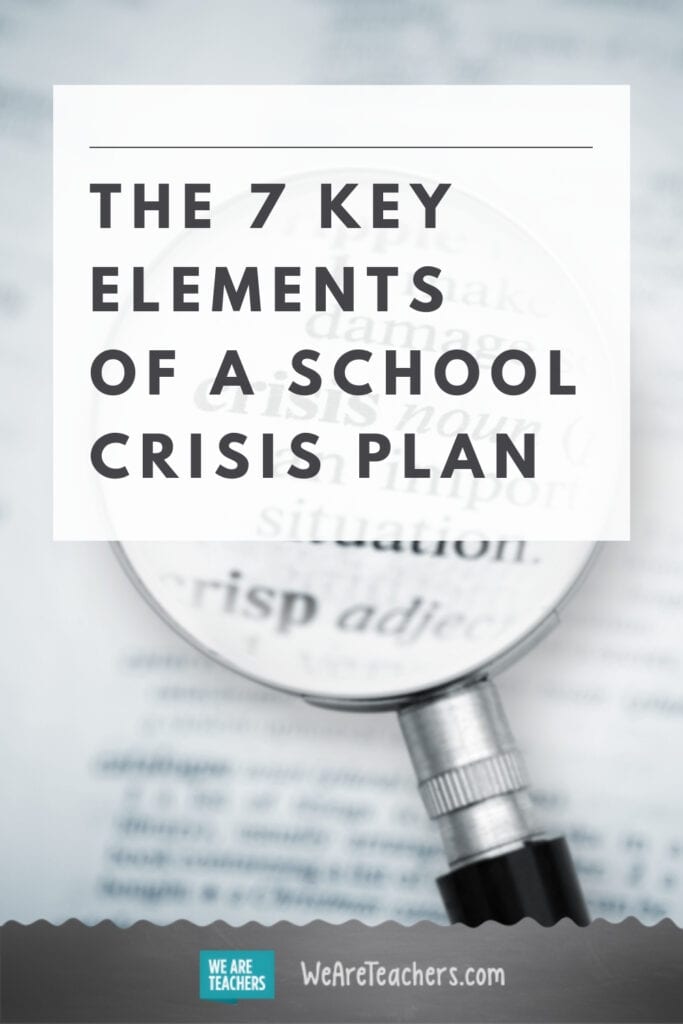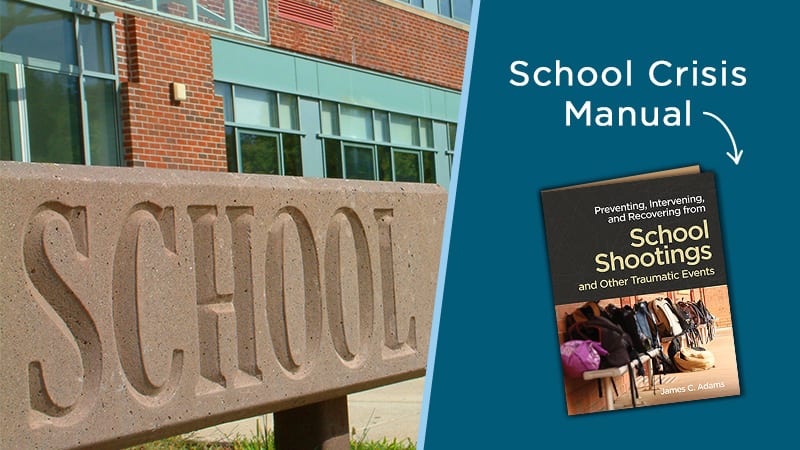Let’s face it. The last thing anyone in a school community wants to think about is the scenario of a traumatic natural disaster or a school shooting. But, having a school crisis plan in place and knowing what to do in the first few minutes following a traumatic event can make the difference between life and death.
We spoke with James Clark Adams, author of “Preventing, Intervening & Recovering From School Shootings and Other Traumatic Events,” for his expertise on how to respond in those critical minutes after a traumatic event.
1. Lockdown your school
Based on the premise that a school has done some of the prevention work ahead of time, each of the players has a different role to play in the first few minutes of the school’s crisis. Your school crisis plan should account for what happens during a lockdown. Instructions should be clear, concise, written, and practiced before an incident occurs.
Lockdown notifications should be immediate, giving students and staff as many opportunities as possible to flee or find shelter.
Adams says the lockdown announcement should be clear and loud enough for everyone on the campus to hear it.
However, Adams says, “What about the students who are in open spaces? Or out in the hallway or outside. What is the response for those staff or students? This is a step that a school needs to have preparation for.”
2. Alert law enforcement and emergency services
Simultaneously, as one school staff member initiates the lockdown procedures, a different staff member should contact law enforcement.
Everyone at the school should know who has the authority to report an event, such as an active shooter, to law enforcement and/or the authority to announce it to the school.
As law enforcement responds, it is essential for officers to have as much information as possible about what they will find on-site.
In a situation where time is critical, being familiar with the environment could very well result in lives saved. Adams says having room numbers on windows can help law enforcement quickly determine where the incident is taking place. Symbols or colors on windows to indicate rooms that may contain potentially harmful or dangerous materials (like a chemistry lab) are helpful too.
3. Announce signals for safety
Once students are in a safe place, the next thing educators want to be concerned about is, “How do I know it’s safe for my students to move from their current location?”
Adams says schools need to create different signals to indicate what the event is and how to respond.
“You want to have a different signal for an active shooter than for a tornado or a hurricane or,” he says. “If it’s an active shooter, you don’t want students leaving their classrooms until law enforcement comes and releases them. But, if it’s a tornado, you want students to come inside the building for safety.”
Many schools simply don’t have different signals for different circumstances.
He adds that when law enforcement arrives, the school’s unique signals, like a pre-planned phrase or unique sound, can help identify those officers to the adults and kids inside a classroom that they are, in fact, police. Officers will typically clear the building one room at a time, doing a thorough inspection of the school to make sure everyone is accounted for, and if necessary, that the suspected perpetrators have been found. Or in the case of a natural disaster, that injured victims are found and triaged as quickly as possible.
4. Remove students and staff from schools
Once students are out of the building, schools need to establish a place where they will go. It could be another school building or a facility large enough to hold the students.
If this place is not within walking distance, your school may need access to busses to move students and staff. Adams suggests schools have a memorandum of understanding with surrounding school districts, so they can use their buses for transportation, or even their kitchens to supply food for staff, first responders, and support personnel if they will be on the property for extended periods of time during the recovery process.
Adams says that having that place to convene is critical. “You need to know who’s in that building, or you can’t know if you’ve got everybody,” he says.
The next step is taking attendance at the gathering spot. This involves checking off names one at a time and making calls for those who you can’t account for.
5. Bring mental health professionals on-site
Within minutes of a school crisis, a mental health team should be on the scene.
The mental health team is a coalition of school mental health counselors, community mental health service providers, and public and private behavioral health care providers trained in trauma treatment. They will lead and oversee the process of providing around-the-clock crisis behavioral health care to anyone affected by the horrific events of the day.
Everyone in the school community could suffer from the trauma of the crisis. “You’re going to have some very broken adults and children,” Adams says.
Some members of the mental health team should be going to the hospital with an injured student to meet parents. If there are fatalities, members of the mental health team should be on-hand at the hospital to provide comfort and support to grieving family members, in any way necessary.”
6. Reconnect families
It’s important to establish a crisis center, which is the place from where all information is disseminated.
Contacting families is the first step. Most school districts have mechanisms in place to quickly contact parents or guardians regarding critical issues in the school district. These may include automated phone calls, texts, or email messages. Having a templated, pre-written script that can be modified in real-time to meet the specific details of the situation on campus can significantly reduce confusion and decrease the lag time between the event and notifying families. Parents and guardians should receive information on what has happened and specific instructions on how and where they may be reunited with their children.
As soon as people in the community learn about the incident, they will flock to the school and could block streets and access to emergency vehicles getting through. This is where pre-planning is critical. Schools and local law enforcement officials need to make sure their joint school crisis plan accounts for traffic, emergency vehicles, and where parents and students can safely be brought back together.”
7. Communicate with the public
Administrators should also create a press release. But, Adams says, this could be pre-written with generic information and then filled in when needed. Keep details simple to start.
Make a list of wounded victims and fatalities, if any. Information about the status of victims. Their names should be released to the media only after family members are informed of the condition of loved ones.
Administrators should confirm the legitimacy of reports of mass trauma. While being accurate and concise to establish trust between the school and community. Designating a district media relations person to make these brief announcements or media posts can reduce confusion.
If police determine the school is a crime scene, you’ll need preparation and police permission to determine who can reenter and when. School staff and students likely left valuables inside the school (keys, medicine, etc…), and will need to return to get them.
Get more tips for preventing, intervening and recovering from crises at school
Ultimately, we all hope we’ll never have to be in a crisis, particularly while at school. But, assuming that something traumatic might happen and preparing for it is the best way to avoid tragic outcomes. For more tips and advice on creating a school crisis plan that prepares your school, check out James C. Adams’ book “Preventing, Intervening & Recovering From School Shootings and Other Traumatic Events.”
LEARN MORE ABOUT HOW TO PREPARE FOR A SCHOOL CRISIS



